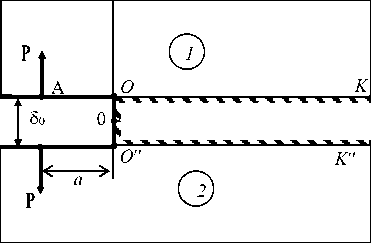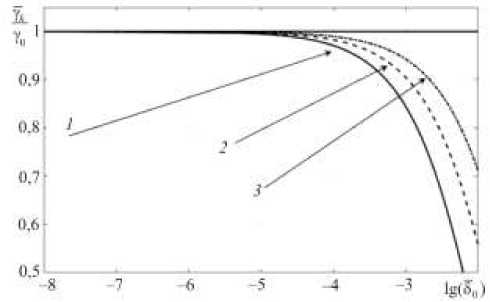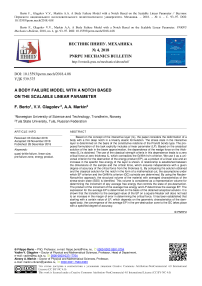A body failure model with a notch based on the scalable linear parameter
Автор: Berto F., Glagolev V.V., Markin A.A.
Статья в выпуске: 4, 2018 года.
Бесплатный доступ
Based on the concept of the interactive layer (IL), the paper considers the deformation of a body with a thin deep notch in a linearly elastic formulation. The stress state in the interactive layer is determined on the basis of the constitutive relations of the Prandtl bonds type. The proposed formulation of the task explicitly includes a linear parameter (LP). Based on the analytical solution of the task in the beam approximation, the dependence of the wedge force on the thickness (IL) is obtained. The use of the classical strength criteria in this dependence leads to a zero critical force at zero thickness IL, which contradicts the Griffith-Irvin criterion. We use it as a universal criterion for the destruction of the energy product (EP), as a product of a linear size and an increase in the specific free energy of the layer is shown. A relationship is established between the dimensions of the sample and the critical force, which ensures independence with a given degree of accuracy of the critical force from the thickness IL. By comparing the solution obtained and the classical solution for the notch in the form of a mathematical cut, the assumptions under which EP criterion and the Griffith's criterion (GC) coincide are determined. By using the Neuber-Novozhilov approach, the structural volume of the material with averaged characteristics of the stress-strain state (SSS) is identified. This volume is considered as a representative volume for determining the increment of еру average free energy that controls the state of pre-destruction. The product of the increment of the average free energy and LP determines the average EP. The expression for the average EP is determined on the basis of the obtained analytical solution. It is shown that the transition to the averaged value of the EP on a square Neuber cell does not lead to an increase in the margin of error in determining the critical force. It has been established that starting with a certain value of LP, which depends on the geometric characteristics of the damaged body, the convergence of the average EP in the pre-destruction zone to the GC takes place with a specified degree of accuracy.
Quasi-brittle failure, linear size, pre-failure zone, energy product
Короткий адрес: https://sciup.org/146281904
IDR: 146281904 | УДК: 539.375 | DOI: 10.15593/perm.mech/2018.4.08
Текст научной статьи A body failure model with a notch based on the scalable linear parameter
ВЕСТНИК ПНИПУ. МЕХАНИКА № 4, 2018PNRPU MECHANICS BULLETIN
Nowadays, excisions in solid bodies are usually treated proceeding from model representations of V- and U-shaped configurations [1–13]. Singular solutions are true for classical V-notches, whereas in rounded U-notches respective measurable curvature radii are responsible for concentrated stresses. In works [7, 8] Neuber proposes to ensure the finiteness of stresses in sharp V-notches by considering an elementary cell in the tip region of a V-notch and treating one half of its width as the notch’s rounded radius. This radius was understood as a material structure with a lengthwise dimension. Because of the introduced proposition, the solution of the stress concentration problem for V-notches contains no singularity; the given approach is further elaborated in works [10–13]. Essentially, the introduction of the virtual curvature radius involves averaging the stressed state of an elementary cell with an estimated size of 0.5 mm. In [14, 15] Novozhilov applied the respective approach to the opening mode crack problem, where the classical singular solution was explicitly averaged by the cell. The atomic spacing was chosen as the characteristic cell size. Neuber’s approach makes use of the solution for the concentrator with a virtual curvature radius, whereas Novozhilov’s approach makes use of the averaging based on the known singular solution. The works in this field are discussed in articles [16–20].
Works [21, 22] propose to consider for the slit-shaped defect the layer of interaction with the averaged stress state. In this case average stresses are found right from the problem’s solution [23, 24] and the solution derived for the defect geometry set in advance is not averaged. In addition, the use of average stresses makes it possible not to set the defect ending geometry.
In this paper we consider the critical state of a sample of finite thickness with a physical section loaded with balanced forces. As a criterion for destruction, the product of the thickness of the IL for the change in the specific free energy, EP [22], is taken. Based on the analytical solution in the beam approximation, a condition, that determines the threshold value of the interaction layer thickness as a function of the geometric parameters of the sample, is obtained. The decrease in the IL thickness for the threshold value is insignificant, within the limits of the predetermined margin of error, affects the magnitude of the critical force.
1. Problem Statement
Let us consider the pre-failure state of the layer with a finite thickness when the stress state in this layer is uniform in thickness and determined only by one component of the stress tensor. For the model representation of the deep excision as a physical cut with thickness δ and the interaction layer with Prandtl links [25, 26] on its continuation see Fig. 1.
It is supposed that Jung’s modulus E in bodies 1 and 2 is identical to the stiffness of the Prandtl links in the interaction layer. The physical cut banks are loaded at distance a from the origin of coordinates with symmetrical concentrated force P referred to the sample thickness. The rest of the external surface of the body is stress free. In addition, we assume that the plane passing through the points KK" is infinitely removed from the origin and is fixed. In this case the stress state in the layer is found as ст 11 =
2 Eu δ 0
where и , ( x^ ) is the vertical displacement of the layer’s boundary OK ' . Because of the problem’s symmetry, only body 1 will be considered. The console’s behavior will be described by correlations from the bending theory [27]. The bending equations for each of the console’s sections are recorded as
Dd “ ‘^2 ) = P ( a + x 2 ) , x 2 e[ xA ; x° ] ,
UX 2
_d 4 u ( x. ) 2 E . . г о- к-л
D — u‘ (x2 ), x2 e [x2 ; x2 J , dx. on
where D — Eh3 /‘2 is the stiffness of a strip with a unit thickness; P is force P projected onto the 0X1 axis.
h
h

X 2
Fig. 1. Loading a sample with a fine notch
where R — 4,
bending torque Du” ( x^ ) , and shearing force Du^ ( x, ) in point O' will be recorded. When wedging effort P is reached, the displacement will reach u in point О’ ; the system of five linear equations relative to k , k , L , L and Р is derived from (3) and recorded as
' Pa 3 /(6 D ) + k2 = L ,
Pa 2 /(2 D ) + k i = R ( L 2 - L ^,
< Pa / D = - 2 R 2 L 2, (4)
P / D = 2 R 3( L i + L 2 ), Pa 3 /(6 D ) + k2 = u .
Then system (4) is used to find constants
1 D/D 1 u ( R 3 a 3 - 3 Ra - 3 )
k = -R(Ra +1)u, k2 = —
-
1 2 3I Ra +1
Formula (9) can be used to find critical force values on the basis of various criteria of strength. It follows from Rankine’s criterion at оп = " k n that
'Pk = "Жа Gk’ ^5h .(10)
If to use specific available energy ф = ф^ =
( " i J2
2 E
as
the criterion of strength, the critical force is found as фPk = ^-h- Vфk 50hE .
The formula of finding the energy product (EP criterion) proposed in works [21,22] for use as the critical condition is and force value
L = u , L2 = -
Ra
Ra + 1
u
2y = 2Y o = 5 o Ф. (12)
Taking account of (12), the critical force equation takes on the following form
2R3D u.
Ra + 1
Y P k = -^ V2Y0 hE . (13)
The formula for the wedging force is derived by substituting equation (1) to (5) and recorded as
R 3 D σ 11 δ 0
E ( Ra + 1 ) ’
Note that conditions (10), (11), and (13) suggest that the stress field in the excision butt region is finite. GC for the excision in the form of a mathematical cut is recorded as [28, 29]
5 =----к k 2^aKIC^ ’
Now let us compare the value of Ra with one. The equation derived from (2) and (3) is recorded as
Ra = a 46 h . (7)
h δ
It follows from representation (7) that one can always determine the range 50 < 5 k at a given a , in which the following condition will be met to a specified accuracy:
a 4/ 6—»1 and Ra + 1 = Ra . (8)
h δ 0
It is essential that δ , meeting condition (8), depends on scale factor a . For example, if a > 10 h , the substitution of (8) at 50 < h - 10 - 2 will lead to an inaccuracy of less than 2 %.
When condition (8) is met, the wedging force-to-butt stress ratio will be recorded as
P =
h
26 a
σ11 δ0 h .
where K is the mode-I fracture toughness.
It is essential that the conditions for the start of the excision’s motion in forms (10) and (11) depend on thickness δ and condition (13) does not depend on the excision thickness given that δ meets (8).
If to make an experimental excision compliant with (8), it will be possible to find the critical force value and then the critical EP value from (13) as
2Y
,,
=
'
Ea
2
-
P
k
.
Since the wedging effort value must not depend on the modeling representation, the EP criterion representation will be found by equaling the critical forces in (13) and (14) and considering the failure viscosity:
K 2
-
2 Y о = -E" .
-
2. Finding Linear Dimension
E
Note that equation (16) corresponds to GC of quasibrittle failure mechanics at γ treated as specific surface energy.
It follows from (16) that the EP criterion is determined by the material properties and does not depend on the inter- action layer’s thickness given that (8) holds. It follows from (13) that the critical force for geometrically similar samples fа Л
I — = const I is proportionate to the square root of the con k h )
sole thickness. Therefore, the scaling effect holds.
Works [30, 31] considered the representative volume for determining the average deformation energy controlling the state of pre-failure. If to consider the EP criterion in the element of the 50 x 50 interaction layer, the EP by virtue of Neuber’s – Novozhilov’s concept will be recorded as
2 Y k = 5 0 , (17)
2 E
1 δ 0
where an = a, j ( x- ) dx^ .
δ 0 0
The average element stress is found by virtue of (1) via the distribution of displacements as
2E1 δ02
G11 = г г I U1 (x2 )dx2 = ^u .
δ0 δ0 0
The average element displacement is found from (3) within the limits of (8) as
u
= u
' e " R 5 0 sin ( R 50 p
R 5»
k 0
Taking account of the latter equation, (18) takes on the following form:
f e" R 5 0 sin( R 5n))
5n = °" ----J ' •(19)
k R 5o
The equation derived from (17) and (19) is discrete element 50 x 50 in relation to y0 from the common logarithm of δ , i.e., the ratio of δ to unit length for steel with Jung’s modulus E = 2.1-1011 Pa. Samples 1, 2, and 3 were taken with h = 0.05 , h = 0.1, and h = 0.2 m. The wedging force application point was selected at a distance a = 10 h .

Fig. 2. Relation of the relative EP value to the linear parameter
The plot number corresponds to the sample number. It follows from analyzing the plots in Fig. 2 that solution (20) restricts the reference value of γ from below. That said, it is possible to choose the range of small values of 50 e ^ 0; 5 k J , where 2 у^ = 2y0 holds to a specified accuracy.
In this respect, layers with thicknesses 50 < 5 k are permissible for the proposed model, whereas the 50 x 50 butt element is the volume of pre-failure within the criterion 2y^ = 2y0. Note that, the increasing console height increases the value of δ k in Fig. 2 by virtue of estimate (22) and behavior of solution (20).
2 γ k
= 2 У о
f e -R Sin ( R 50 )Y k R^ )
Conclusion
The equation derived from (20) at 50 ^ 0 is
2у k = 2у о ( 1 - R5 o ) 2 . (21)
Assuming that accuracy 2 γ must be less than 2% of 2γ , the estimate of the ratio of layer thickness δ to console height h is found from (21) as
5 0. < h
( 0,01 ) 4
0,001 .
At a > 10 h estimate (22) restricts the LP-console height ratio and assumption (8) will hold to an accuracy of less than 1.2 %.
The behavior of EP γ in the layer’s butt zone (solution (20)) is shown at variously configured excisions in Fig. 2 on
The statement of the problem with an explicitly introduced LP has shown the possibility of using the EP as the criterion of failure. This criterion allows finding to a specified accuracy the critical load compliant with GC. The finiteness of stresses for materials with pronounced elastoplastic properties, within the framework of known criteria, allows one to take into account the nucleation and development of plasticity zones in the state of pre-fracture. The follow-up studies will take account of the influence of all the components of the stress tensor in the interaction layer on the basis of the variation statement [21] with the explicitly introduction of the LP, including for non-symmetrical loading and taking account of elastic plastic material properties.
Acknowledgement
The work is made with the financial support of the Russian Foundation for Basic Research (Project Nr. 18-31-20053).
Список литературы A body failure model with a notch based on the scalable linear parameter
- Gross R., Mendelson A. Plane elastostatic analysis of V-notched plates, International Journal of Fracture Mechanics, 1972, vol. 8, no. 3, pp. 267-276. https: DOI: 10.1007/BF00186126
- Bazant Z.P. Scaling of Structural Strength. Elsevier, 2005, 336 p.
- Panlilio F. Elementary Theory of Structural Strength. John Wiley & Sons Inc, 1972, 478 p.
- John C., Chilver A.H., Ross C.T.F. Strength of Materials and Structures. Fourth ed. 1999, 706 p.
- Gymez F.J., Elices M., Valiente A. Cracking in PMMA containing U-chaped notches, Fatigue Fract. Eng. Mater. Struct., 2000, vol. 23, no. 9, pp. 795-803. DOI: 10.1046/j.1460-2695.2000.00264.x


